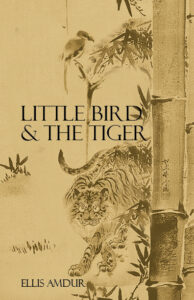Partly because of my just released novel, Little Bird and the Tiger, which, among other themes, explores the tension between tradition and modernity in the Meiji period, the thought of Amur (Siberian) tigers come to mind. They are the largest big cats – growing up to 400 kilos. As you surely know, they live in the far north, surviving comfortably in weather under -50 degrees centigrade.They hunt and kill brown bears (!) When they attack, they simultaneously bite and also clamp down with their spread armed fore-paws, both teeth and claws penetrating the body of their prey as if it is one giant set of jaws. Such an attack has the spread of the bite of a tyrannosaur. They are rare, they are marvelous, and may soon go extinct.
Let’s say we want to preserve these magnificent beasts. So, we set up a reserve for them in Greece, Australia, or the Southwest United States. There is not much of a winter. We can send deer into the reserves so that they can kill live prey, but space will be limited. Instead of roaming for hundreds of kilometers, their customary range, they will only roam for a few, and they will be forced to frequently compete with each other for space and food. Because they don’t typically interact with other tigers, except during mating, the one’s that will survive are those that (unnaturally) are more comfortable in close proximity to one another. Because of the climate, they will, over generations, lose their thick fur and their undercoat of body fat, and gradually become smaller (no need to preserve body heat and with smaller prey, speed and agility will become more important than power). With our interference, they will soon evolve something different from Amur tigers. So, let’s go further. Let’s say we want them to continue to live – but we want to breed into them a placidity, even a timidity, regarding humans, because they might be dangerous to their keepers. Therefore, we breed out not only those that are aggressive, but even those that are confident.
Classical martial traditions are such an Amur tiger. Within each such art, there are developments and changes from generation to generation, including reworking of some kata, or studying a principle in greater depth. Some may even develop new forms, new training methodologies, or even new fields of study to be congruent with changes within society. When this is properly done, however, it is for the purpose of enhancing their essential “Amur tiger nature.” There is knowledge within each traditional martial art that only exists because it is still traditional. To be sure, some of the information held within a specific martial tradition can be relevant beyond the precincts of the school itself, and in terms of their role in society, this may be among the most important reason that they should continue to exist. This includes some of the world’s most sophisticated psychological understanding of what it means to be in direct confrontation with an armed individual who intends your death. What I have written in The Coordinator/The Accord Agent, books that were an outcome of my participation in a project for the Defense Advanced Research Project Agency (DARPA), is grounded in principles derived from Tenshin Bukō-ryū and Araki-ryū. If my predecessors had homogenized either of these two arts into hard-core generic hand-to-hand combative art, or something like kendō or judō, all that is unique to them would have been lost, including fine-grained information concerning the ability to manage people in extreme, life-threatening states. I know for a fact that the information I gleaned and have provided to others has saved people’s lives. If my ryūha die, then that knowledge will die – and conceivably, people, in the future, will die as well. We are not living antiques, and we are not merely adaptable combative systems that change as the environment affects it, like mongrel dogs. We strive to be that Amur tiger, that living beast.
As the generations pass, particularly in these modern times, there will be real forces driving change within martial traditions. That should happen, but only if there is an anchor: the core principles of your tradition must be understood, embodied and lived. If you abandon them, then your Amur tiger, after a few generations, may still be a fierce beast, but not one that hunts bears to feed its young. If you regard your traditional art with the same respect that I do mine, then you realize that there is powerful information that only can exist within its aegis and nowhere else. Tigers hunt alone.
eBook & Print Editions


Leave a Reply
You must be logged in to post a comment.